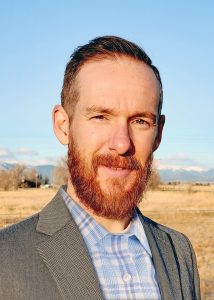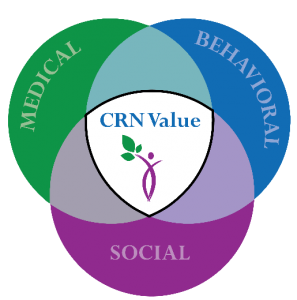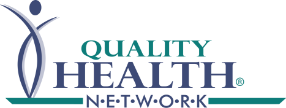Overall health is shaped by a multitude of factors from each of the medical, behavioral, and social spaces. It does not neatly reside within just one of these silos of care. Single dad Walter’s unemployment can lead to overdue bills, food insecurity, and poor nutrition for his two young boys.

How can we get the right teams in place at the right time to help Walter and his family? We know he needs help now, and if we wait, that help will be less likely to have a positive outcome, require more time, and be more costly. What if we could get Walter and his family the help they need earlier?
Quality Health Network (QHN) developed the Community Resource Network (CRN) to remove the barriers to accessing and coordinating care through its person-centric Community Information Exchange that is integrated with QHN’s secure, award-winning Health Information Exchange infrastructure. CRN gives medical, social service, and behavioral health providers a rich, shared data set focused on the ‘whole person’ view to better communicate, prioritize actions, collaborate, and improve client outcomes.
CRN will allow organizations to better coordinate care for individuals and across their communities. Using the data to find meaningful insights requires an understanding of the technology, the care systems, and its people. To accomplish this critical role, QHN recently added Jason McRoy – a leading health and social services analytics expert – to the CRN team.

The CRN platform is currently in the beta phase of production and being tested at participating Mesa County, Colo. organizations. However, in an age where we are data rich but information poor, how can we use the data collected from Walter to not only give him the help he needs today, faster but also predict and risk stratify the help he may need in the future?
Data-rich but information poor. Unfortunately, this is the state of current healthcare, as legacy system modernization accelerates with greater access to cloud and hybrid data solutions. Despite innovations in business intelligence and data integration technologies, real data solutions remain somewhat elusive. It takes an adept person to navigate and understand the nuances of business units and key decision drivers to craft a truly meaningful narrative from data, and QHN found that skillset in Jason.
Jason joined the QHN team as an independent contractor who will work to provide analytic intelligence and strategic risk stratification services for their latest innovation that is the CRN.

McRoy brings nearly 18-years of experience in the human services and health industry to QHN, including his role as Deputy Account Director with IBM Watson Health Division on a project in partnership with the CO Department of Healthcare Policy and Financing, as well as his time as Division Director for the Business Operations and Systems Division of Boulder County Housing and Human Services (BCDHHS) where he led the department in the implementation of BoulderConnect, a community portal connecting citizens, government and community service providers.
We sat down with Jason on his first week on the job to talk about the future of healthcare, and how new technologies and data storytelling will be the driving force behind transforming the overall health of our communities.
You worked on some cutting edge projects involving health data. What ‘lessons learned’ do you think you will bring to the CRN from that experience?
I think about data as a way to help tell a story. In that sense, my biggest lesson learned relates to being attentive to the stories that need telling. This involves working closely with practitioners and stakeholders to understand what the challenges and successes are; how the system works for them and what the limitations might be. From there you can usually dig into the data and start to reveal a narrative that helps inform or explain in concrete terms what people already may intuitively know.
You‘ve stated that “technology is best experienced as a seamless interface with business.” How do you think you can help make the CRN experience seamless for providers and care-givers?
Really good technology should almost be transparent to the user. Certainly, you know when you’re using a system or not. But the way you navigate the system, how the system provides you with information or anticipates the types of questions you want to ask; these are the things that differentiate really good technology from ‘just another program.’ In my experience, staff in the health and human services field already have enough systems to use; and many of these don’t always live up to their promised utility. My hope is to help CRN not just be another system, even if it is a really good, purposeful one. To really tip the scale, we should aspire for CRN to be a truly value-added solution, something users find themselves not being able to do without.
Some of the big players like Centene, Kaiser, etc. are very interested in the development of SDoH-focused solutions to improve health and reduce healthcare costs. In what ways do you think QHN is “ahead of the game” as far as addressing the ‘whole-health’ issue today?
I have seen the focus on the SDoH really gain momentum in the past few years. It seems that across health care and at the federal program level there is a clear understanding of what a whole-health program focus should theoretically offer to health and human services systems. The challenge is no one has fully realized this; communities are still wrestling with the best way to realize this vision. Some are closer than others, but for now, it doesn’t look like there’s a clear blueprint. QHN has the right amount of engagement and partnership from the community at the table to figure out what a community-oriented whole-health solution should look like. This puts QHN well ahead of the curve because they have worked closely with the community to identify whole-health use cases that the technology is being designed to address.
People are so much more than data points on a graph. In your wildest dreams, how do you want to see data best serve the people they represent ten years from now?
The optimal use for this data is to clearly tell the story of need, service, and success. We should be able to use data to be strategic about what the most critical needs are and how best to affect them. At that point the data can help direct and inform service delivery, identifying connections that perhaps previously may have been missed and guiding people to the right services at the right time. The data ultimately helps guide and facilitate connection; the real magic, however, lies in the service organizations. They do the hard work, and if the data is really optimized it will clearly show the outcome of this work. To have systems and services that have longevity, the data must clearly show the value proposition and the return back to the community at large.
For more info on the CRN, please visit www.communityresourcenet.org.



